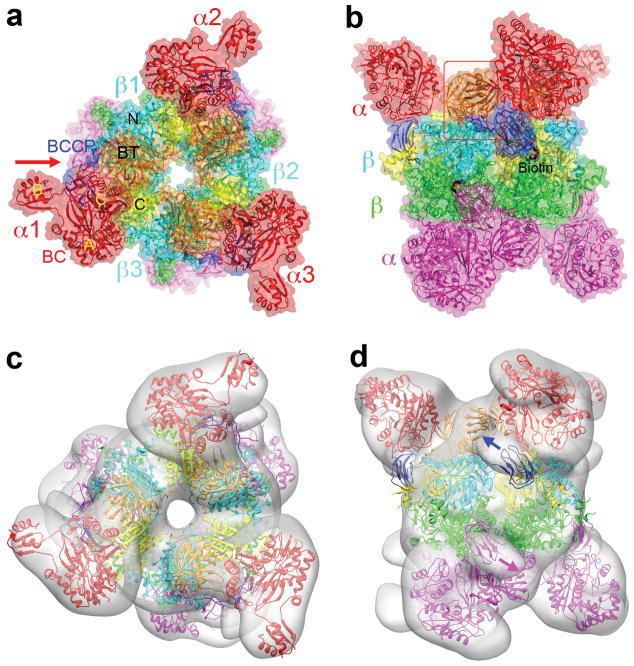EC number 6.4.1.3 ExPASy NiceZyme view | CAS number 9023-94-3 | |
 | ||
Propionyl-CoA carboxylase catalyses the carboxylation reaction of propionyl CoA in the mitochondrial matrix. The enzyme is biotin-dependent. The product of the reaction is (S)-methylmalonyl CoA. Propionyl CoA is the end product of metabolism of odd-chain fatty acids, and is also a metabolite of most methyl-branched fatty acids. It is also the main metabolite of valine, and together with acetyl-CoA, is a metabolite of isoleucine, as well as a methionine metabolite. Propionyl-CoA is thus of great importance as a glucose precursor. (S)-Methylmalonyl-CoA is not directly utilizable by animals; it is acted on by a racemase to give (R)-methylmalonyl-CoA. The latter is converted by methylmalonyl-CoA mutase (one of a very few Vitamin B12-dependent enzymes) to give succinyl-CoA. The latter is converted to oxaloacetate and then malate in the Krebs cycle. Export of malate into the cytosol leads to formation of oxaloacetate, phosphoenol pyruvate, and other gluconeogenic intermediates.
Contents
- Enzyme Structure
- Enzyme Mechanism
- Isozymes
- Pathology
- Of Propionyl CoA Carboxylase
- By Propionyl CoA Carboxylase
- References
Enzyme Structure
Propionyl-CoA Carboxylase (PCC) is a 750 kDa alpha(6)-beta(6)-dodecamer. (Only approximately 540 kDa is native enzyme. ) The alpha subunits are arranged as monomers, decorating the central beta-6 hexameric core. Said core is oriented as a short cylinder with a hole along its axis.
The alpha subunit of PCC contains the biotin carboxylase (BC) and biotin carboxyl carrier protein (BCCP) domains. A domain known as the BT domain is also located on the alpha subunit and is essential for interactions with the beta subunit. The 8-stranded anti-parallel beta barrel fold of this domain is particularly interesting. The beta subunit contains the carboxyltransferase (CT) activity.
The BC and CT sites are approximately 55 Å apart, indicative of the entire BCCP domain translocating during catalysis of the carboxylation of propionyl-CoA. This provides clear evidence of crucial dimeric interaction between alpha and beta subunits.
The biotin-binding pocket of PCC is hydrophobic and highly conserved. Biotin and propionyl-CoA bind perpendicular to each other in the oxyanion hole-containing active site. The native enzyme to biotin ratio has been determined to be one mole native enzyme to 4 moles biotin. The N1 of biotin is thought to be the active site base.
Site-directed mutagenesis at D422 shows a change in the substrate specificity of the propionyl-CoA binding site, thus indicating this residue’s importance in PCC’s catalytic activity. In 1979, inhibition by phenylglyoxal determined that a phosphate group from either propionyl-CoA or ATP reacts with an essential arginine residue in the active site during catalysis. Later (2004), it was suggested that Arginine-338 serves to orient the carboxyphosphate intermediate for optimal carboxylation of biotin.
The KM values for ATP, propionyl-CoA, and bicarbonate has been determined to be 0.08 mM, 0.29 mM, and 3.0 mM, respectively. The isoelectric point falls at pH 5.5. PCC’s structural integrity is conserved over the temperature range of -50 to 37 degrees Celsius and the pH range of 6.2 to 8.8. Optimum pH was shown to be between 7.2 and 8.8 without biotin bound. With biotin, optimum pH is 8.0-8.5.
Enzyme Mechanism
The normal catalytic reaction mechanism involves a carbanion intermediate and does not proceed through a concerted process. Figure 3 shows a probable pathway.
The reaction has been shown to be slightly reversible at low propionyl-CoA flux.
Isozymes
Humans express the following two propionyl-CoA carboxylase isozymes:
Pathology
A deficiency is associated with propionic acidemia.
PCC activity is the most sensitive indicator of biotin status tested to date. In future pregnancy studies, the use of lymphocyte PCC activity data should prove valuable in assessment of biotin status.
Of Propionyl-CoA Carboxylase
a. Carbamazepine (antiepileptic drug): significantly lowers enzyme levels in the liver
b. E. coli chaperonin proteins groES and groEL: essential for folding and assembly of human PCC heteromeric subunits
c. Bicarbonate: negative cooperativity
d. Mg2+ and MgATP2−: allosteric activation
By Propionyl-CoA Carboxylase
a. 6-Deoxyerythronolide B: decrease in PCC levels lead to increased production
b. Glucokinase in pancreatic beta cells: precursor of beta-PCC shown to decrease KM and increase Vmax; activation
